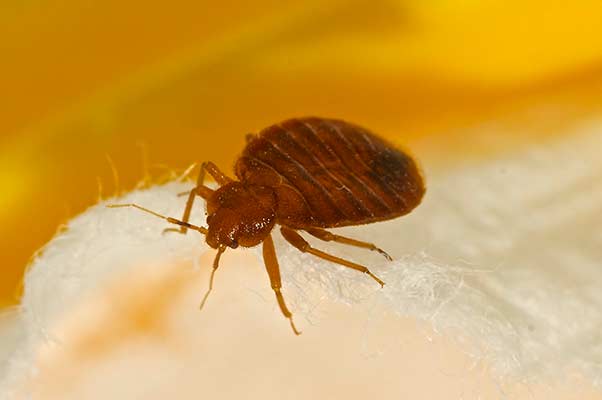Bed Bug Biology and Pheromones: The Key to Professional Extermination
Every professional bed bug exterminator must have a deep understanding of bed bug biology and pheromones to effectively eliminate these pests. In this blog post, we will take a closer look at bed bug biology and the role pheromones play in their behavior, and discuss the key reasons why this knowledge is essential for the success of professional exterminators.
Bed Bug Biology
Bed bugs (Cimex lectularius) are small, wingless insects that have adapted to exclusively feed on human blood. Initially, they were mainly found in temperate climates but have now spread worldwide due to increased travel and movement of people. Bed bugs are nocturnal, hiding in cracks and crevices during the day, and coming out to feed at night when their host is asleep. Understanding their biology and life cycle can help exterminators better target treatments and prevent future infestations.
Life Cycle of Bed Bugs
- Eggs: Female bed bugs lay about 1-5 eggs per day and up to 500 in their lifetime. Eggs are tiny and white, typically hidden in crevices and difficult to spot.
- Nymphs: After hatching, bed bugs go through five nymph stages, each one requiring a blood meal to molt and grow. Nymphs resemble smaller versions of adult bed bugs but are lighter in color.
- Adults: Adult bed bugs are approximately 4-5 millimeters long and are reddish-brown in color. Both males and females require regular blood meals to reproduce and survive.
Pheromones and Bed Bug Behavior
Pheromones are chemical substances secreted by insects that trigger certain behaviors in other members of the same species. In bed bugs, pheromones play a crucial role in:
- Aggregating: Bed bugs release aggregation pheromones that help them find suitable harborage locations and group together in large numbers.
- Reproduction: Male bed bugs are attracted to females by sex pheromones, allowing them to locate and mate with receptive females.
- Alarm signals: When bed bugs are disturbed, they emit alarm pheromones that warn other bed bugs of potential danger, causing them to scatter and seek refuge.
Importance of Bed Bug Biology and Pheromones for Professional Exterminators
- Targeted treatments: Understanding bed bug biology enables exterminators to develop targeted treatments that correspond to each stage of their life cycle, ensuring complete elimination.
- Effective monitoring: By comprehending bed bug aggregation behavior and their reliance on pheromones, exterminators can develop effective monitoring strategies using pheromone traps and inspection techniques.
- Informed prevention: Knowing the reproductive and feeding habits of bed bugs helps professionals educate their clients on how to prevent future infestations, such as proper sanitation and avoiding items that could harbor bed bugs.
- Innovative control methods: As scientific research advances our knowledge of bed bug pheromones, exterminators can leverage this information to develop innovative control methods, such as pheromone-based lures or repellents.
In conclusion, a solid grasp of bed bug biology and pheromones is crucial for any professional exterminator. It helps them develop targeted treatments, improve monitoring techniques, prevent future infestations, and stay informed on the latest advances in control methods. As a result, Bills Pest Termite Control in Arizona can provide effective and reliable services to clients dealing with bed bug infestations.

Affordable Bed Bug Testing in Phoenix Az 602.308.4510
Are there scents that attract bed bugs?
Yes, there are several scents that can attract bed bugs. Here are a few based on the provided search results:
- Carbon Dioxide (CO2): Bed bugs are drawn towards the carbon dioxide that humans exhale, especially when we are sleeping. They use it as a key indicator to locate potential hosts.
- Body Heat and Human Scent: Along with CO2, bed bugs are attracted to the warmth and scent that a human body emits. This is considered one of the primary reasons bed bugs tend to feed at night when people are typically asleep.
- Dirty Laundry: The scent of dirty laundry, particularly those with human sweat and scent, is known to attract bed bugs.
Understanding these attractions allows us at Bills Pest Termite Control to not only execute effective treatment plans but also provide our customers with crucial preventive advice, further protecting them from possible infestations.
Are Bed Bugs attracted to pheromones?
Yes, bed bugs are indeed attracted to pheromones. Pheromones play a crucial role in bed bug behavior and are used as a communication tool amongst these pests. Here are specific ways in which bed bugs respond to pheromones:
- Aggregation: Bed bugs release aggregation pheromones that act as a signal to other bugs, encouraging them to group together in sizeable numbers in selected locations.
- Attraction: Certain chemical attractants or pheromones are known to lure bed bugs out of their hiding spots. These specific scents could potentially be used in bed bug traps.
- Alarm signal: When bed bugs are disturbed, alarm pheromones are emitted, warning other bugs about potential danger and promoting defensive behaviors.
Understanding the role of pheromones in bed bug behavior is key for both monitoring and controlling these pests. By leveraging this knowledge, pest control professionals can develop more effective strategies for bed bug management.
Do bed bugs leave pheromone trails?
Yes, bed bugs do leave pheromone trails. These are essentially chemical signals that insects use to communicate with each other. Bed bugs release pheromones to mark potential feeding or hiding spots, to signal danger, or to attract mates. These pheromone trails serve as a guiding mechanism for bed bugs to navigate their environment. Some researchers have even developed synthetic pheromones to lure bed bugs into traps.
By understanding these traits and behaviors, pest control professionals like us at Bills Pest Termite Control can use scientific methods to detect and treat bed bug infestations more effectively.
Bed Bug Biology and Pheromones – 602.308.4510
Bed Bug Related Information:
-
- Need a Bed Bug Test for your home?
- Bed Bug Services
- Bed Bug Treatment Quote
- Bed Bug Spray
- Best Bed Bug Treatment
- Cost of Bed Bug Treatment
- Bed Bug Removal
- Bed Bug Pest Control
- 5 Bed Bug Facts
- How do I tell if I have Bed Bugs
- Got Bed Bugs in your Luggage?
- Expert Bed Bugs Treatment
- Bed Bug Exterminator
- FREE Bed Bug Inspection
- Bed Bug Free Certification
- Tropical Bed Bugs
- Bed Bug Heat Treatment or Chemical Treatment?
- Bed Bug Extermination
- Bed Bug Prevention
- Do Bed Bugs Cause Allergies
- Bed Bugs at Hotel
- How to get rid of Bed Bugs
- Bed Bug Biology
- ARS 33-1319
- Bed Bug Look-alikes
- Chandler Bed Bug Expert
- Bed Bug Inspection Chandler
- Bed Bug Inspection Mesa




